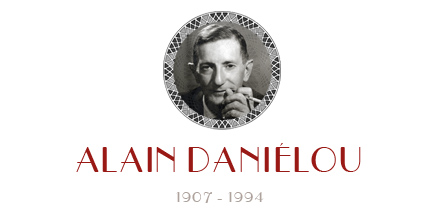EDITO
 Happy Equinox!
Happy Equinox!
The year commemorating the tenth anniversary of Alain Daniélou’s death has been constellated with events and publications spreading his work. It has come to an end with the launching of 3 books and 2 catalogues:
– The Song-Poems of Tagore, with Bengali text, French and English translations and adaptation for voice and piano by Alain Daniélou, published by Editions Michel de Maule.
– Approche de l’Hindouisme: the fourth of the Mleccha’s Exercise Books, edited by Jean-Louis Gabin, Editions Kailash.
– La via del Labirinto, Alain Daniélou’s autobiography published in Italian by Casadeilibri, Padua.
– The catalogue of Alain Daniélou’s works.
– the Spanish-Catalan catalogue of the Daniélou/Tagore exhibition by Casa Asia of Barcelona.
Having been busy with many activities over the past months, I wish to thank most cordially the people and organisations in charge of the various events and publications.
Julien Bassouls for lending us his premises to present the Semantic
Christian Braut for his invaluable aid with all our I.T. problems
Marie-Laure Bruker for preparing the catalogue together with Anne Prunet
Lorenzo Casadei, publisher of “La Via del Labirinto”
Elisabeth de Condappa, director of the publishing house Kailash for the publication of the fourth of the Mleccha’s Exercise Books
Georgette David for her preface on the poet in the volume “Song-Poems of Tagore”
Thierry de la Croix, director of the publishing house Michel de Maule for the great care taken with the volume “Song-Poems of Tagore”
Ion de la Riva, Director of Casa Asia for organising the great Daniélou/ Tagore exhibition in Barcelona
Laura Francolini, translator of Alain Daniélou’s works in Italian
Jean-Louis Gabin for the introduction and the preparation of the fourth volume of the Mleccha’s Exercise Books, which has aroused great interest
Rossanna Gatteschi for her subtle analysis of the complexity and importance of Alain Daniélou’s works in her remarkable article in Italian in “India”, the magazine published by the Embassy of India in Rome
Menene Gras-Balaguer of Casa Asia, who organised and prepared the magnificent and voluminous catalogue of the Daniélou/Tagore exhibition
Kenneth Hurry, translator of Alain Daniélou’s works in English
Raghunath Manet and his music and dance ensemble for the show given at the Cini Foundation
Alain Perrottet and Radio Suisse Romande for their series on Alain Daniélou
Louise Tschabuschnig and the Atelier Glück in Milan for organising the evening “Danser le labyrinthe”, homage to Alain Daniélou
The Istituto Venezia e l’Oriente and the Istituto di Musica Comparata for the Alain Daniélou Commemoration Day at the Cini Foundation
The Librairies Itinéraires of Paris and La Mandragore of Chalon-sur-Saône for making it possible for us to set up the exhibition “Lumières de l’Inde”
The many Alliances françaises throughout India which presented the exhibition.
And not forgetting my collaborators:
Sylvain Dumont and Giorgio Pace
for their constant and effective assistance
Jacques E. Cloarec, Centre Daniélou
ACTUALITÉS
Le coup de coeur de la FNAC Montparnasse : – Rabindranath Tagore – Poèmes chantés
Présentés, traduits et adaptés par Alain Daniélou, Préface de Georgette David, Editions Michel de Maule, Paris, Janvier 2005.
Rabindranath tagore often used to say that his songs would live in Bengal long after his name and his writing were forgotten. Although it is difficult to believe that the literary achievements of this great Bengali poet might one day be forgotten, today we see that his literary works are already considered as classics
that is, belonging to the past _, while his songs, sung by everyone in every part of Bengal, belong to the eternal present.
During the nineteenth century, Indian classical music in Bengal developed in many ways an over-refined technique, performed only by highly trained specialists and fully appreciated only by a select audience. The musical form from created by Tagore maintains the essential features of the classical Indian system of music, but brings its rare power of expression within reach of all. Tagore was always deeply moved by the human predicament. His songs, with their simple but vigorous melodies, have given voice, expression, to the feelings of millions of men and women. These songs can be heard everywhere, in wealthy city home, in lonely rice fields, on the rivers or in the fishermen’s huts, in the village street or the university hall. Their ringing words know no difference of creed, race, caste or age. Within a few years, Tagore’s music conquered the whole of Bengal and still pervades the rhythms of everyday life with evercherished melodies. Today, Hindu India and Muslim Bangladesh have both chosen songs by Tagore as their national anthems.
– Les Cahiers du Mleccha – Vol IV
APPROACH TO HINDUISM
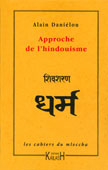 This Approach to Hinduism, appearing ten years after the death of Alain Daniélou, provides important data on the tolerance and incredible richness of traditional Hinduism, in which “since the beginning, scholars and philosophers have studied, without prejudice, the enigma of man and the universe, have sought to understand, to know, not to believe or preach”. In the Hinduism that Daniélou got to know through its arts and sciences, through Yoga, its concepts of death, love, social life, or even drugs, the co-existence of opposites is always “where the divine lies”. Thus, any westerner travelling to India is rarely insensitive to that simple but relaxed, reverent but courteous relationship of the Hindus with the gods, with flowers, scents, the ornamental animals in the temples, music, the beauty of rites, statues and ceremonies. What is striking is that it appears not to be a question of “belief” – with all that the word implies of voluntary sentimentality and deadening of the critical spirit -, but a spontaneous, cosmic sympathy, the happy bathing in a natural harmony that we ourselves have lost.
This Approach to Hinduism, appearing ten years after the death of Alain Daniélou, provides important data on the tolerance and incredible richness of traditional Hinduism, in which “since the beginning, scholars and philosophers have studied, without prejudice, the enigma of man and the universe, have sought to understand, to know, not to believe or preach”. In the Hinduism that Daniélou got to know through its arts and sciences, through Yoga, its concepts of death, love, social life, or even drugs, the co-existence of opposites is always “where the divine lies”. Thus, any westerner travelling to India is rarely insensitive to that simple but relaxed, reverent but courteous relationship of the Hindus with the gods, with flowers, scents, the ornamental animals in the temples, music, the beauty of rites, statues and ceremonies. What is striking is that it appears not to be a question of “belief” – with all that the word implies of voluntary sentimentality and deadening of the critical spirit -, but a spontaneous, cosmic sympathy, the happy bathing in a natural harmony that we ourselves have lost.
Editions Kaïlash, Paris-Pondichéry / “Le Message de l’hindouisme“, 2004 / Series grouping various texts by Alain Daniélou..publisher, Studies and preface by Jean-Louis Gabin.
EXPOSITIONS
– Part of the “Lumières de l’Inde” exhibition will be presented at the Atelier Glück, 45 Via Glück, Milano, from April 11 to 17 2005. Organised by Louise Tschabuschnig.
The other part ill be on show at FNAC, Milan, from April 6 to 30 2005. Organised by Kamel Benhamou.
COLLECTION
– THE MLECCHA’S EXERCISE BOOKS
Collection edited and presented by Jean-Louis Gabin.
Collections of unpublished documents, articles and conference papers, given by Alain Daniélou from New York to Moscow, and from Teheran to Benares. They tackle subjects as different as music, Hinduism, Yoga, the castes, tolerance and fanaticism, eroticism, Tantrism, the modern world, the cosmic cycles, the search for wisdom and happiness. Like the Darshanas, these contradictory points of view which, according to the Hindus, are alone in giving unblinkered access to the reality of the world, the bringing together of these at once scholarly and incisive texts casts a new light on the thought of this great Indian scholar.
Soon to appear in English:
A Civilisation of Differences
Under preparation in English:
Shivaism and Primordial Tradition*
Approach to Hinduism*
Kama-Yoga, The Body is a Temple exchanges with Rene Guénon
Music of the World*
The Universal Message of the Gita*
Language, Symbols and Intercultural Relations*
Theatre, Dance and Arts of India*
Miscellany*
(*) provisional title
ZOOM SUR
– Speech by M. Henri Sauguet (23/03/1985)
Bestowal of the Insignia of the Rank of Officer of the National Order of Merit
In asking me to confer on you today the insignia of the rank of officer of the National Order of Merit, which the Government of the French Republic has just bestowed on you, you have taken care, Dear Alain, to entrust this honour to one of your oldest friends. Indeed, we have known each other for…. more than fifty years: it was only yesterday, at the Hôtel Nollet, where we were living, you and I, under the mischievous, friendly and affectionate eye of the poet-painter Max Jacob, who turned the place into a page of history.
At the time you were a dancer, and sometimes you danced to my piano improvisations. And we lived, you and I, in the midst of young artists, who are all famous nowadays, who gave a shape to the century whose youth we were.
When was it that you received the call of the Hindu world that became your adopted home, to which you devoted both your life and work, which have made you one of its most authentic, most knowledgeable and most radiant propagators? I remember that one day you left to go and meet Rabindranath Tagore, who was to have such a great and deep influence on you. You left Paris and your friends, who so often gathered at your atelier on rue Montsouris (which you dubbed la Montsouricière), in response to the call of a legendary world, which we then knew so little and so badly, whose fascinating beauty you have revealed to us. Its music, first and foremost, which you have drawn so close to that it has become familiar, on which you have written books that have made us understand and feel its flowing, subtle and refined greatness.
Then its sculpture, a world bursting with faces, forms, postures, with divine sensuality, since it is only found on and around the temples, together with this whole living ancient civilisation whose secret dignity you have handed on to us. For all this, it would clearly be impossible not to acknowledge your merit. And it is this merit that today sets you apart in the eyes and to the ears of all those who have an interest in those other things that enrich the spirit and come to the aid of our western world through their spirituality, their detachment from the world and their substantial unreality.
Above all, it teaches us not to count the days as days, to annihilate the fleeting time that overtakes us if it becomes our reference for life and thought. In Hindu music, in its monumental proportions, we glimpse the great light of eternity, which is what makes your works and your life so brilliant, Dear Alain, you who have known how to be unique as a free being in choosing this homeland whose music remains the language of the gods.
H. Sauguet
– The day organised at the Cini Foundation in Venice by the Istituto Venezia e l’Oriente together with the Istituto Interculturale di Studi Misicali Comparati to commemorate the tenth anniversary of Alain Daniélou’s death saw several events attended by an audience, many of whom from far away. They included the presentation by Alfredo Cadonna, Jean-Louis Gabin, Giovanni Giuriati et Wim van der Meer of Alain Daniélou’s vast musical-indological card-index archive, now being digitised by the Cini Foundation. A video of the show organised in Paris for his eightieth birthday was also projected and the day ended with a much appreciated exhibition by Raghunath Manet and his troupe, now one of the best-known Indian dance companies in the world.
– 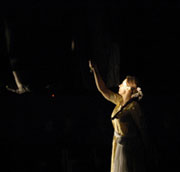 The events organised in Milan in November by the Atelier Gluck with the collaboration of the Centre Culturel Français in Milan and the Academic Course of Indology of the Vicenza Conservatoire met with great public success. They included the presentation to a packed audience by Giuliano Boccali, Sylvano Bussotti, Louise Tschabuschnig and Jacques Cloarec at the FNAC in Milan on November 24th.
The events organised in Milan in November by the Atelier Gluck with the collaboration of the Centre Culturel Français in Milan and the Academic Course of Indology of the Vicenza Conservatoire met with great public success. They included the presentation to a packed audience by Giuliano Boccali, Sylvano Bussotti, Louise Tschabuschnig and Jacques Cloarec at the FNAC in Milan on November 24th.
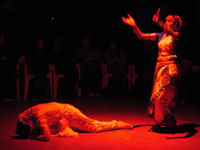 This was followed next day by a show in honour of Alain Daniélou entitled “Danser le Labyrinthe” at the Atelier Glück, interpreted by Louise Tschabuschnig, Gianfelice D’ Accolti which signed the setting in scene and the Indian dancer Chitrangee Uppamah, combining a play with classical Indian dance, based on Shilappadikaram, a Tamil story translated by Alain Daniélou. This greatly appreciated performance was followed by highly convivial Indian buffet supper.
This was followed next day by a show in honour of Alain Daniélou entitled “Danser le Labyrinthe” at the Atelier Glück, interpreted by Louise Tschabuschnig, Gianfelice D’ Accolti which signed the setting in scene and the Indian dancer Chitrangee Uppamah, combining a play with classical Indian dance, based on Shilappadikaram, a Tamil story translated by Alain Daniélou. This greatly appreciated performance was followed by highly convivial Indian buffet supper.
GALERIE
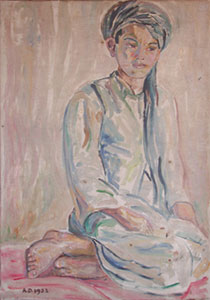 Alain Daniélou
Alain Daniélou
« Portrait »
Huile sur toile,
Afghanistan,
1932.
EXTRAIT
– Shiva and Dionysus, The Omnipresent Gods of transcendence and Ecstasy
Inner Tradition International, Rochester, U.S.A.
Shiva and Dionysos are both guarantors of values whose common trait is that they belong outside or are against the laws of the city: nomadism, renunciation, the calling in question of social structures and hierarchies. Friends of the poor, of artists and vagabonds, they attract the suspicion or mistrust of representatives of the established order. Through these two figures with their undeniable similarities, Daniélou explores not only the domain of religion, but also – which is inevitable in dealing with Hinduism – those of society, culture, history and art.
Drawing on sources whose extreme variety highlights their value, he shows how Shivaism has left its sign on Asiatic and European civilisations up to the far west since the Iron Age – an Age ironically named, since most of its artistic creations were made of perishable materials such as wood, traces of which are extremely rare. This is why the mark left by Shivaism is not obvious and can be apprehended only when seen from a Hindu and not from an exclusively western point of view. The testimony of ancient authors, monuments (megaliths, for example), the Upanishads and Purānas – the Sanskrit texts that hand down the teachings of Shivaism -, contemporary authors, whether Anglo-Saxon, Indian or French, all provide material on which the author draws in order to demonstrate this relationship in various civilisations.
This work has to fight a second preconception, that of Hinduism as a rigid and petrified society, with its hierarchical and ordered castes, but this means ignoring the presence of Shivaism, which is earlier than Hinduism.
Daniélou explains that since the Aryan colonisation, two perfectly opposite tendencies have co-existed in India: Vedism, with its written tradition founded on the Vedas, which provided the structure of Hindu society and represents the sedentary and ordered way of living, and Shivaism, earlier than the Aryans, with its oral tradition.
Lastly, in its presentation of Shivaism, this work highlights the area beyond reality, which has always been man’s chief preoccupation: religion, in the primary meaning of the word. Shivaism seeks the ties between the different spheres of existence, investigates all the various paths, whether scientific, intellectual or artistic. Indeed, it is striking to note how close literary or artistic creation is to Shivaism, an “active participation in an experience that goes beyond and upsets the order of material life”.
Thus, it is disturbing to read the Rig Veda description of Shiva’s companion “with his long hair, clothed with the wind”, or Daniélou’s explanation of Shivaite initiation as “the real transmission of a Shakti, or power, which takes the form of enlightenment”. We may think of Rimbaud, that wandering, lawless poet, author of enlightenment and “the man with the wind for his feet”.
Shiva and Dionysus “is not an essay on the history of religions”: the book opens with this disclaimer. It is much more, a multifacetted text, like all the author’s works, an essay on the origins of human settlement, civilisations, social structures, languages and creation.
CD-ROM
– Alain Daniélou – Le labyrinthe d’une vie
Painting, drawing, photos, singing, the vina, musicological and Indian studies, mythology, religion, history, society : Alain Daniélou took an interest in so many fields that it is difficult to approach them all, and even more so to unite them. Here’s precisely what Xavier Bellenger has managed to do on this CD Rom, presenting the multi-faceted work of this unclassifiable artist-philosopher and lover of beauty, with his untiring search into the mystery of creation.
MUSIQUE
– The Semantic
A presentation of the instrument, its design and its possibilities by their conceptionist Michel Geiss and Christian Braut is envisaged in the second fortnight of June 2005 with Lifelive association. For more informon, please contact Lifelive.
 Developed on the initiative of Alain Daniélou and at his request, and tuned according to his theory, the Semantic is an electronic musical instrument designed by Michel Geiss, Christian Braut and Philippe Monsire. It is the successor of a previous version, the S52, created by Claude Cellier and André Kudelski. The S52 was devised to check the theory, but as an instrument was difficult to play, due to ergonomics.
Developed on the initiative of Alain Daniélou and at his request, and tuned according to his theory, the Semantic is an electronic musical instrument designed by Michel Geiss, Christian Braut and Philippe Monsire. It is the successor of a previous version, the S52, created by Claude Cellier and André Kudelski. The S52 was devised to check the theory, but as an instrument was difficult to play, due to ergonomics.
The Semantic has been designed as a complete musical instrument. To make it easier to play, Alain Daniélou decided to utilize only 36 of the 53 notes of the scale (cf. Annex 2), considering the other notes less essential.
The Semantic is a “ready-to-play” instrument, fully self-contained, and user-friendly for composers and musicians. The instrument comprises a Kurzweil K2000 R sound generator and two Midy 20 Cavagnolo button keyboards. A powered amplifier is incorporated to avoid any need for external amplification. The Semantic will offer a choice of twenty or so different tones (the spectrums of which will be designed to highlight Alain Daniélou’s theory). To enhance the performance, the keyboard is velocity-sensitive (speed with which the keys are pressed), as well as aftertouch-sensitive (pressure variations while the keys are being pressed). Furthermore, sustain and expression pedals and faders are provided to produce an effect on volume attack and release parameters, on spectrum, etc.
Among other reasons, the K2000 R was chosen because each note can be tuned to one-cent accuracy. In other words, at the worst, the pitch of a note programmed on this instrument could only deviate by half a cent from its theoretical value – a very low margin of error allowed by Alain Daniélou. By way of example, raising notes C1 (65.406 Hz) and C6 (2093.005 Hz) by one cent corresponds to increasing their frequency by 0.0378 Hz and 1.209 Hz respectively.
As compared to the usual piano keyboard, the button keyboard has two distinct advantages. Firstly, its aspect is sufficiently different from the former which, to the musician’s mind, is synonymous with the tempered scale. It was thought that with a new instrument like the Semantic, it would be better to break away from accepted ideas. Furthermore, with respect to the average finger span, a greater number of notes can be reached than on a piano keyboard, which is essential considering that it has three times more notes than the piano keyboard.
Though, the Semantic comprises two keyboards with 105 keys each, corresponding to a range of almost 6 octaves. At the same time, it is possible to transpose by semitones or octaves. The space required for the 105 keys is a mere 18 by 4 inches. For comparison, one octave on the Daniélou scale takes up 5.2 inches, whereas on a piano keyboard the same number of notes would need 14.4 inches, or nearly three times as much.
